If you are looking to invest in a powerful heater that doesn’t encroach on your space, why not consider a tower heater?
Tower heaters can heat rooms quickly and effectively and tend to be energy efficient. Choosing the model you want can be a little tricky, and depends on your needs and lifestyle.
Here is a guide that delves into the options available and how to select the ideal tower heater for you, with some pointers on the most effective models available at the moment.
At a Glance: Our Top Picks for Best Tower Heaters
- OUR TOP PICK: Lasko 5307 Oscillating Ceramic Tower Heater
- RUNNER-UP: Hurricane 736609 Series Heatwave Radiant Heater
- HONORABLE MENTION: Lasko 755320 Ceramic Tower Heater
Comparison of the Best Tower Heaters
| IMAGE | PRODUCT | |
|---|---|---|
Our Top Pick  |
| View Latest Price → |
 |
| View Latest Price → |
 |
| View Latest Price → |
 |
| View Latest Price → |
 |
| View Latest Price → |
 |
| View Latest Price → |
How Do You Choose the Best Tower Heater?
When choosing a tower heater, there are a few important things to consider related to your own lifestyle. Firstly, you want to think about the size of the room that you want to heat. In general, you need 10 watts for every foot square of space in the room. The wrong size heater will either be too powerful or unnecessarily expensive and energy-wasting or will not have enough power to heat the room. You can estimate your heater’s wattage with the calculator below.
With this in mind, electric heaters can sometimes be expensive, so compare the initial cost with the cost of running in terms of wattage, to work out which heater will be most effective in the size room you want for the lowest overall cost.
Secondly, in terms of energy efficiency, unfortunately, space heaters do not yet have a standardized efficiency rating system. However, by choosing the right power capacity for your room, you will find the heater to be more efficient. Additionally, look for heaters with a thermostat to keep a consistent temperature, and with programmable timers, and eco or energy saving modes.
You may also want to think about safety. If you have small children or pets, you may want to consider a heater that is cool-to-touch. Equally, look for heaters with shut-off mechanisms in case of overheat. Some tower heaters come with a tip-over mechanism that shuts it off if it falls over, a great feature to reduce fire risk around children and pets.
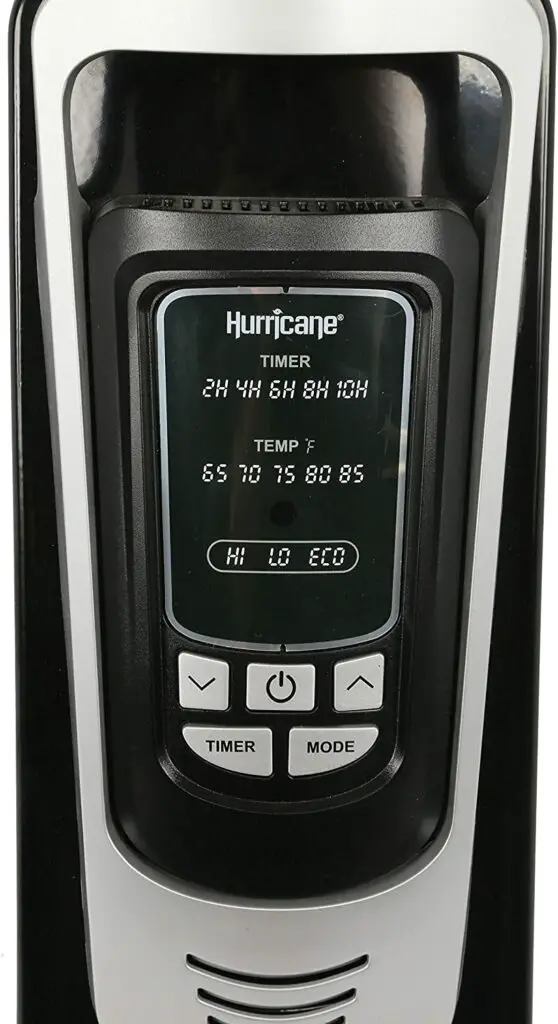
If you are moving your heater from room to room for zonal heating, you may want to consider its portability. Tower heaters can come with wheels for more easy movement. Also, consider the weight and whether it has a handle or not.
Another thing you may want to look at is the ease of operation. Many heaters now come with a variety of programmable settings to make it easier to automate the heating experience. However, some can be very confusing. Consider what you will be using it for and how much control you want over your heat.
Some heaters can be loud. Noisy heaters generally have fans inside. If you are using the heater in the bedroom, a loud fan can be disturbing, so take this into account.
While often overlooked, there is also the aesthetic aspect. You are adding a feature to your home, so you want it to be consistent with your current decor. Try to find a heater that fits in with your home image, so it doesn’t interrupt the flow of the ambiance.
Reviews of the Best Tower Heaters
When choosing a tower heater, you can get lost in the wide range available on the market. Remember to consider your own personal preferences as a starting point for short-listing the heaters you want. Here are a few of the best models out there to help you understand what you are looking for.
Best Overall
Lasko 5307 Oscillating Ceramic Tower Heater
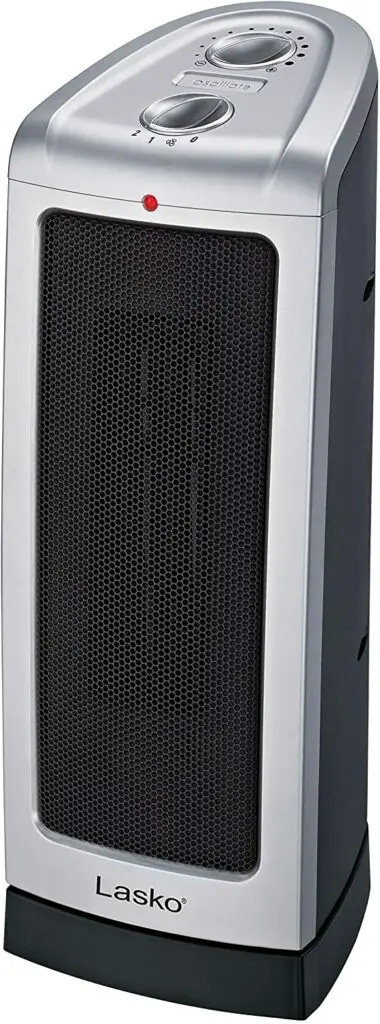
Specifications
Coverage Area (sq ft): N/A
Power (watts): 1500
Dimensions: 6.75 x 5.6 x 16.02
Weight: 4.6 pounds
We may earn commission from purchases made from our links, at no additional cost to you
To be used on either the floor or a table, this model has three settings or high, low, or fan only. It has 1500 watts of power and can oscillate, while also featuring overheat protection.
It is a small heater that is surprisingly powerful. While it is less impressive when is not oscillating, the moving settings allow it to heat the room well.
Pros
Despite having a fan, it is extremely quiet
Versatile and can be used on the floor or on a table
Has an electronic thermostat to keep the room at a consistent temperature
Can oscillate or it can be kept static allowing for direct heat or convection heat
The fan can work on its own meaning this model can be used in hot weather as well as cold
Cons
Cord and plug seem to heat up when are set to the maximum temperature
Heat doesn’t always seem to travel well out of the heater if you don’t set it to oscillate
Runner-up
Hurricane 736609 Series Heatwave Radiant Heater
Specifications
Coverage Area (sq ft): N/A
Power (watts): 1500
Dimensions: 26 x 15 x 6.5
Weight: 19.25 pounds
We may earn commission from purchases made from our links, at no additional cost to you
A remote-controlled whole room heater, this device is an oil-filled radiant heater with 1500 watts of power and three temperature settings. It has a low surface temperature and is on wheels for better portability.
This heater works very well and is safer than most for children and pets. It is convenient to use and to move around the house, but it is a little noisy.
Pros
Easy to program, and the remote is very convenient
Wheels make this heater easy to move from room to room
Heats the room well even on eco mode, a setting that also helps to lower the cost of bills
The low surface temperature makes it safer for children and pets than other devices using the same technology
Cons
It is noisy
The remote beeps and has limited angles
Honorable Mention
Lasko 755320 Ceramic Tower Heater
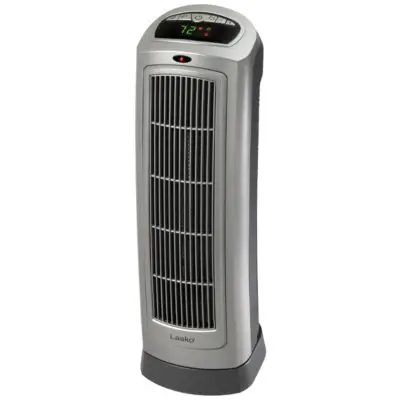
Specifications
Coverage Area (sq ft): N/A
Power (watts): 1500
Dimensions: 7.25 x 8.6 x 23
Weight: 8 pounds
We may earn commission from purchases made from our links, at no additional cost to you
This model has a self-regulating ceramic heating element and 1500 watts of power. It has a programmable thermostat and an 8-hour timer as well as being able to oscillate. It has automatic overheat protection and a handle for easy portability.
It is an easy-to-use heater with a good variety of functionalities to suit your needs. The temperature stays consistent, and it has added safety features. However, be careful when moving it as it is easy-to-drop it and can damage the ceramic.
Pros
Overheat protection is a good safety bonus to help prevent a fire risk
While being a good size, it is quite lightweight and has a top handle, making it easy to move around
Oscillation and the self-regulating ceramic elements spread heat quickly and effectively around the room
Easy-to-operate, this model has a programmable thermostat and 8-hour timer which enables you to set it to your most comfortable mode
Cons
Cord gets hot which is a bit of a fire risk
The handle is a little slippery which makes it easy to drop. This can damage the ceramic
Best Ceramic Tower Heater
Lasko 5160 Ceramic Tower Heater

Specifications
Coverage Area (sq ft): N/A
Power (watts): 1500
Dimensions: 8.5 x 7.25 x 23
Weight: 6.45 pounds
We may earn commission from purchases made from our links, at no additional cost to you
This ceramic heater oscillates for better convection. It has a programmable thermostat and two heat settings, with 1500 watts of power. It features a remote control and digital display.
It is a convenient-to-use heater which gives out a lot of heat while not taking up much room. However, the thermostat is not very accurate and can only be used if you are using the heater on full power.
Pros
Very quiet even when it is oscillating
Heats rooms very effectively and quickly despite being very small sized
Remote control is very convenient and fits neatly into the handle socket
Cons
Thermostat is not the most accurate
Thermostat only works when set to the highest setting, which uses a lot of electricity
Best Oscillating Tower Heater
Honeywell HCE311V Digital Ceramic Compact Tower Heater

Specifications
Coverage Area (sq ft): N/A
Power (watts): 1500
Dimensions: 8.74 x w6.69 x 12.8
Weight: 3.18 pounds
We may earn commission from purchases made from our links, at no additional cost to you
With 2 constant heat settings and a timer, this oscillating heater has a dust filter, and tip-over and overheat protection. It is a ceramic heater that uses 1500 watts of power.
Surprisingly powerful for such a small heater, it oscillates with a wide berth, heating the room very quickly. It has great safety features, but they are a little oversensitive. It is also not a good idea to sleep with this fan as it is a little noisy.
Pros
Has wide oscillation which helps to heat a whole room evenly
Very quick to heat up a room and surprisingly powerful despite not being very large
Has a timer that has 4-time settings, making it convenient for use and energy efficient
Exceptional safety functions, making it a great choice for people with children and pets
Cons
Fan is noisy, and so are the beeps when the buttons are pushed
Tip-over function is a little oversensitive and cuts off heat with even the slightest bump
Best Infrared Tower Heater
COSTWAY Portable Quartz Heater

Specifications
Coverage Area (sq ft): N/A
Power (watts): 1200
Dimensions: 11 x 6.7 x 22.4
Weight: 6.72 pounds
We may earn commission from purchases made from our links, at no additional cost to you
What Recent Buyers Report
Receiving great customer satisfaction and proving to be worth the money makes this heater the ultimate device to toast your rooms, offices, or workplaces, etc. It provides a uniform heating environment and warms up any space instantly. The adjustable settings and portable construction have majorly contributed to making it a customer favorite. Moreover, it lends a homey feel due to the silent operation and the dim orange hue emitted from the heater.
Why it Stands Out to Us
The efficient heat generation, paired up with unwavering quality and safety features, is the main highlights of this product to make it an insightful purchase. With an easy operation, the quartz heating element is productive enough to sustain a warm and comfortable atmosphere. It takes up little space, and the construction quality is applaudable. Furthermore, this heating tower has a built-in thermostat that shuts off the system in case of overheating to prevent any kind of damage.
Bottom Line
All in all, the COSTWAY Portable Quartz Heater is a wonderful buy to fight off extreme colds at a budget-friendly price. The energy-saving feature is a massive relief on electricity bills, and to top it off, it does not compromise on the radiant heating capabilities. It won’t disturb you in any way regarding noise, pollution, dust, chemicals, or fumes, etc.
Pros
Powerful and consistent heating method by radiations
Adjustable settings to regulate heat and save up on electricity
Lightweight, easy to carry around, and free of noise and pollution
Safety features will protect you from hazards in case of overheating
Thermostat automatically maintains a uniform temperature in the room
Cons
Front cover gets extremely hot to touch
Extreme heating capabilities require precautions to avoid burnt floors and carpeting
Types of Tower Heaters
Tower heaters are tall and thin, which makes them a great space-saving option when heating a home. There are three main types of tower heaters: ceramic, oscillating, and without blades.
Ceramic
Ceramic tower heaters send electricity through the ceramic plates, giving the benefits of consistent heat, without the fire hazard or burn risk.
Oscillating
Oscillating tower heaters spin around, so you get full coverage of the room as the heater directly blows heat out.
Blade-less
Tower heaters without blades are aesthetically beautiful, not presenting health or safety issues, especially for children and pets.
Ceramic Tower Heaters vs. Oil-Filled Tower Heaters
Ceramic tower heaters usually work using convection heat. Electricity heats up the ceramic plates, and a fan is used to blow the heat around the room. It creates a circular motion of hot air, as it displaces cool air in the room. However, there are a few designs of ceramic heaters that work using radiant heat.
Electricity heats the ceramic plates, and the heat is left to radiate from these ceramic components, without being blown around the room by a fan. Convection heaters tend to be faster at heating the room. Ceramic heaters tend to be less hot to touch.
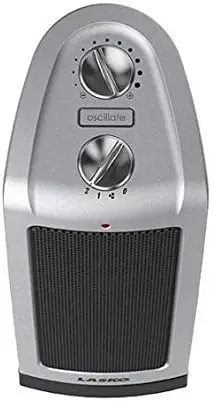
Oil-filled tower heaters are generally all radiant heaters. The columns of the tower heater are filled with oil. There is an electrically powered heating element which heats the oil inside the heater. Oil has quite good thermal mass, so it holds the heat for a long time. The heat radiates upward from the oil, through the metal heater through conduction.
They are a little slower to work with than ceramic heaters, however, they tend to keep the room consistently warm for a longer period of time. They take a while to cool down so they will stay hot even after the power is shut off. They are very hot to touch though so they can be a hazard to children and pets.
How Does a Tower Heater Work?
The working is pretty much straightforward. Tower heaters are dependent on electricity to keep them performing their function. The ceramic plates get warmed up by the current running through them. After getting heated to a maximum range, a fan blows the heat into the room. This warm air dispels cold air by taking up its place and pushing the cold air into the heater. Consequently, hot air starts rising in the room to create a snug atmosphere.
A tower heater is a versatile and practical solution to keeping you warm in your house or workplace. They occupy floor space, but being tall and sleek gives them an edge in being functional space-savers and heating devices. They ensure uniform heat exposure over a broad spectrum, using energy conserving and fast heating methods.
Cautious Considerations to Keep in Mind
Before you decide on a product, being armed with the right amount of information is crucial to making your investment profitable. As far as tower heaters are concerned, you need to be cautious regarding certain factors such as power, energy consumption, heating controls, safety features, and user-friendliness. Read along to learn about some features that shouldn’t be neglected when making a purchase.
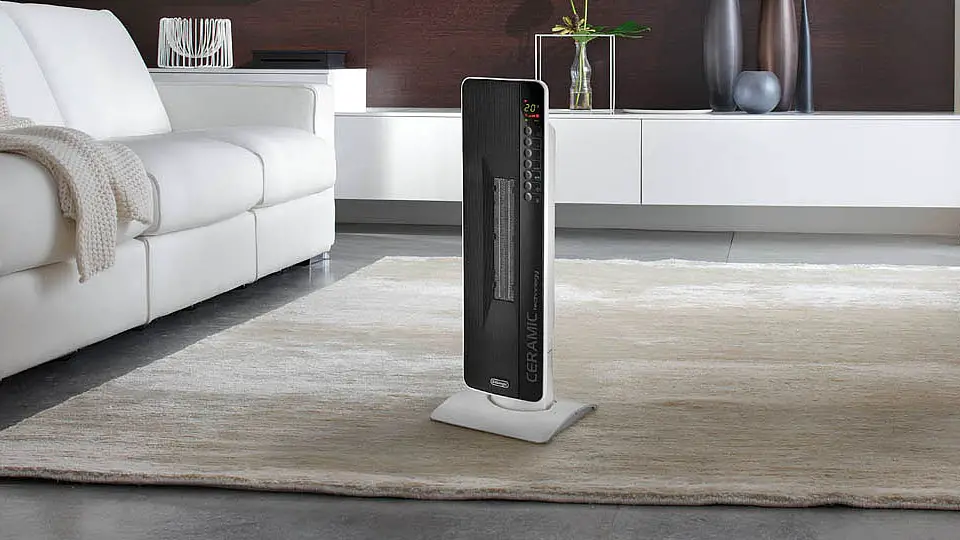
Power and Efficiency
The wattage of your heat determines the power delivered to offer a good heating experience. Normally, tower heaters feature 1500 to 2000 watts, which is adequate for rooms, kitchens, drawing rooms, etc. If you demand a heater that covers up more space, you’ll need to look for something with higher wattage. Also, make sure to purchase an energy-saving heater. This will improve efficiency and significantly cut down on electrical expenses too.
Heating Controls
Versatility and adjustable features are something that makes a product stand out from the rest. Variable heat settings will give you an upper hand in controlling the level of warmth in your room; hence, you can set it according to your preference.
It is advisable to look for heating mode because markets are lined up with a huge variety of heaters. Some tower heaters use infrared heating technology, while others use ceramic fan heaters, so go for something that suits your needs.
Safety Features
Never compromise on safety features when you’re looking for a tower heater. These are crucial to saving you from potential risks of burns and fires. Great installation in most heaters is the overheat protection that will automatically shut off the circuit if the appliance gets too heated up.
Tower heaters tend to fall off more often, so a tip-over protective feature comes in handy to disable it in case it tips over. The remote control is another convenient quality to operate the heater from a distance.
User Friendliness
When deciding on a model, it is preferable to opt for something compatible with your needs. The design should be contemporary, adhering well to the interior of your room. Portability is also a useful feature that makes the heater easy to move around. Noise-free tower heaters are guaranteed to save you from disturbances, and keep you cozy and comfortable.

How to Clean a Lasko Heater Tower
Heater towers demand proper cleaning and regular maintenance to ensure smooth running with maximum efficacy. Thorough cleaning is required every two months to avoid dust buildup and improve longevity. Read along to learn an easy guideline on how to clean your Lasko heater tower in no time at all.
Study Your Heater
Lasko heaters are designed such that you won’t need to open up the heater for cleaning. This saves immense time and effort by only cleaning the exterior vents. Start by examining the heater tower for intake and exhaust vents. A great tip to identify is to remember that the intake vents are located at the rear, whereas the exhaust vents are situated on the front to expel air.
Vacuum the Vents
To get rid of dust particles that frequently reside in the vents, you’ll have to start by using a vacuum brush. Line the bristles of the brush along with the vents and swipe it up and down several times to cleanse it thoroughly. The vacuuming has to be done on both vents.
In case you feel that a vacuum brush is not doing the job well, you can try using a compressed air can. Blow a few bursts of air into the vents to push out the dust particles, and then repeat the vacuuming to ensure your heater is dust-free.
Clean the Exterior
After the vents have been cleared of all dirt, it’s time to clean the heater’s body. Tower heaters are usually situated on the floor, which is why they tend to get dirty with spots and stains. Rubbing a soapy cloth with soft fabric material will not only get rid of the stains but is bound to renew the shine on your heater, giving it a brand-new look.
If you’re confused, here’s a video on how to clean the air vents of your heater tower for an improved heating experience.
Conclusion
Tower fans are great space-saving options for any home, as they are tall, and have thin aesthetics, which means they don’t need much room. Look for something that can be moved around easily for zonal heating and consider the safety features, especially when you have small children.
With this in mind, first, think about the technology and then delve into the many features, from controllable thermostats to oscillation and remote control units.
People Also Ask
If you are in search of an energy-efficient and powerful way of distributing heat into your home, you may want to consider a tower heater. These FAQs might give you some help if you are planning to install one at home.
The electricity consumed by your tower heater primarily depends on the wattage. Usually, tower heaters don’t consume a lot of electricity because the latest models have energy-saving features to cut down such costs.
Most heaters lie within a 1500-watt range, so keeping it running for 8-16 hours would cost you $2-$3 per day, which is not too expensive. Lowering your thermostat temperature from its standard setting and turning on the heater only when needed will help you save money and energy.
Lasko tower heaters offer a great variety of adjustable features that adhere well to customer choice. To run your electrical heater, plug it in the socket and wait for a red light to indicate that the appliance has started.
Turn on the heater by the ‘Power’ button. You can press the ‘Mode’ button to set it on a high or low heat state, depending on your environment’s coldness. Pressing the ‘Power’ button once more will turn off the heater, and don’t forget to take the plug out of the socket.
The heat controls can vary in terms of three settings – high heat with a high-speed fan, high heat with a low-speed fan, or low speed with a low-speed fan. Such versatility makes these tower heaters extremely convenient for daily use in different areas and temperatures.
The area covered by a tower heater is based on the power supply and oscillatory features. Generally, a 1500-watt appliance can generate enough heat to cover up an area of 144-150 square feet. This is the equivalent of a medium-sized room, indicating that tower heaters are more than enough for workplaces, bedrooms, kitchens, etc.
However, you need to remember that if the room is not properly insulated or has many windows, you might require two to three heaters. These units won’t get the job done in the case of large offices, living rooms, garages, etc., so you’ll need to look for something with greater wattage.
Tower heaters are excellent as they require less manual labor and effort, and they are energy-efficient. Moreover, they are properly designed and built to function properly for a long time, and they guarantee fast heating. They can be easily transferred to other rooms as well.
Ceramic tower heaters are quite beneficial for home use as they can heat up the room pretty quick, while also making sure that it is not scalding hot, so there are no health hazards or a risk of fire being started. The hard, ceramic center ensures the safe functioning of these heaters.
